Haiku – a short, traditional Japanese poem, usually about the seasons or nature – is a form that often finds its way into elementary classrooms. Invite students to write Haiku poems – traditionally written in English using a pattern of five syllables in the first line, seven syllables in the second, and a third line of five syllables – by reading several of the books listed below and then take kids on a poetry walk, as suggested in Carole Cox’s Reading Rockets lesson, “Literature-Based Teaching in Science: Poetry Walks.”
Hi, Koo! – A Year of Seasons by Jon J. Muth (Scholastic Press, 2014)
From Kirkus’s starred review : “Long before photography, poets took to haiku, the poetic equivalent of a snapshot, and painters to the suggestive medium of watercolor to capture the essence of moments in nature. Caldecott Honoree Muth (Zen Shorts, 2005) employs both, with the help of his playful panda Koo, to present 26 moments through the seasons.”
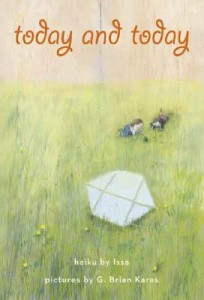
today and today Haiku by Issa, pictures by G. Brian Karas (Scholastic Press, 2007)
From the flap copy: “Selected and arranged by gifted illustrator G. Brian Karas to tell of an ordinary, extraordinary year in the life of one family, these haiku bring to light the preciousness of this moment, and the wonder of today.”

Cool Melons Turn to Frogs! The Life and Poems of Issa, story and Haiku translation by Matthew Gollub, illustrations by Kazuko G. Stone (Lee & Low, 2004)
From Publisher’s Weekly: “This superb homage to the 18th-century Japanese haiku master is as elegant and spare as the poet’s form. Gollub’s (The Moon Was at a Fiesta) brief biography introduces Issa’s pertinent haiku and tells the story of Issa’s transformation from a sad child (his stepmother thwarted his gift) to a recognized, talented poet.”
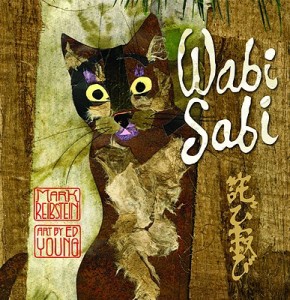 Wabi Sabi by Mark Reibstein, art by Ed Young (Little, Brown Books for Young Readers, 2008)
Wabi Sabi by Mark Reibstein, art by Ed Young (Little, Brown Books for Young Readers, 2008)
From the flap: “Using spare text and haiku, Mark Reibstein weaves an extraordinary story about finding real beauty in unexpected places. Ed Young complements the lyrical text with breathtaking collages.”
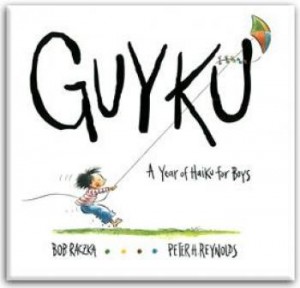 GuyKu: A Year of Haiku for Boys by Bob Raczka and Peter H. Reynolds (HMH Books for Young Readers, 2010)
GuyKu: A Year of Haiku for Boys by Bob Raczka and Peter H. Reynolds (HMH Books for Young Readers, 2010)
From the flap copy: “When you’re a guy, nature is one big playground—no matter what the season. There are puddles to splash in the spring, pine trees to climb in the summer, maple seeds to catch in the fall, and icicles to swordfight with in the winter…So what kind of poetry best captures these special moments?… Why, guyku, of course!”
Don’t miss How to Write a Haiku by Bob Raczka and the other GuyKu resources HERE.
Won Ton: A Cat Tale Told in Haiku by Lee Wardlaw, illustrated by Eugene Yelchin
From Booklist, starred review: “Although the subtitle says haiku, as Wardlaw explains in her opening author’s note, the poems that make up this picture-book celebration of the child-pet bond are actually written in similarly structured senryu, a form that focuses on personality and behavior instead of on the natural world, as haiku does. Here the central personality belongs to a feisty shelter cat who has never known cozy domestic life: ‘Nice place they got here. / Bed. Bowl. Blankie. Just like home. / Or so I’ve been told.'”
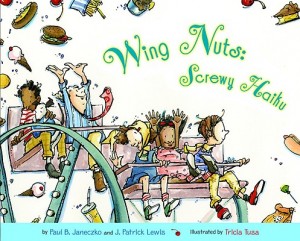
Wing Nuts: Screwy Haiku by Paul B. Janeczko and J. Patrick Lewis, illustrated by Tricia Tusa (Little, Brown Books for Young Readers, 2006)
From the flap: “Senryu, the kissin’ cousins of haiku, are poems of snickers and laughter. Short, punchy, and punny… This spirited collection of senryu will leave children rolling with laughter as they untangle the riddles and wordplay.”








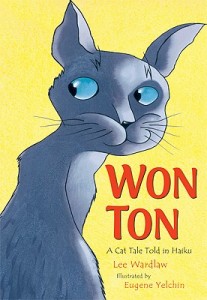



Loved this post about Haiku, Dianne. Maybe because I love every one of the books you highlighted. I had read about Hi, Koo recently and added it to my list of “must haves.” Can’t wait to add “Wing Nuts: Screwy Haiku” as well, then I will have all of these great poetry books in my home library.
It didn’t start out to be a Haiku only post, but I’d gathered up so many books with Haiku, that it seemed too good to pass up. That, and Haiku seems to be one poetry form that’s taught in lots of classrooms. It’s nice to have a collection to share with kids, and I didn’t even mention all of them!
Thank you for a look at such a variety of books that show haiku as both fun and expressive, from the serious or philosophical to silly.